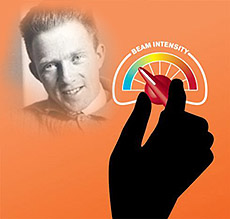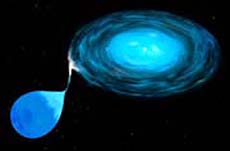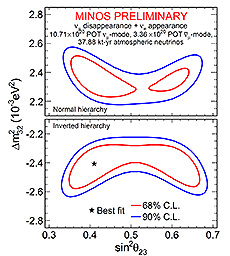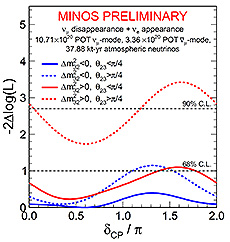|
Friday, Aug. 30
- Breakfast: chorizo and egg burrito
- Breakfast: blueberry-stuffed French toast
- Teriyaki chicken breast
- Smart cuisine: white-fish florentine
- Country-fried steak
- Baked ham and Swiss ciabatta
- Malaysian curry chicken
- Clam chowder
- Texas-style chili
- Assorted pizza by the slice
Wilson Hall Cafe menu
|
|
Friday, Aug. 30
Dinner
Closed
Wednesday, Sept. 4
Lunch
Menu unavailable
Chez Leon menu
Call x3524 to make your reservation.
|
|
Exploring the impossible
 |
German physicist Werner Heisenberg realized that, in the subatomic world, energy doesn't have to be conserved. This realization led physicists to understand that high-intensity particle beams, such as those planned for future Fermilab Intensity Frontier research experiments, could probe phenomena not accessible with the high-energy beams at the LHC.
|
One of the most rock-solid principles of physics is the conservation of energy, which simply means that energy can neither be created nor destroyed. Energy can slosh around and change forms. It can convert from the potential energy of a drawn bow to the kinetic energy of an arrow in flight to the sound energy of the "thwack" as the arrow hits its target. If you learn nothing else in a physics class, you learn that energy is conserved.
Thus it may be a little disconcerting to later learn that this principle isn't quite as cut and dried as you were originally taught. In the quantum realm, energy conservation isn't absolute. It turns out that in the world of the ultra-small, energy can not be conserved as long as the time that it isn't conserved is brief. Further, the greater the unconserved energy, the shorter the time during which this weird state of affairs can happen.
To understand how this works, think about how you might go about lending money to a fiscally unreliable friend. If he asked to borrow a dollar, you'd give him the money and not worry too much about when you'd get it back. The loan is small, and if you didn't see the money for a long time, it would probably be OK. On the other hand, if you loaned him $100, you might want to be repaid in a week or so. If you loaned him $100,000, you'd probably want to get that money back right away.
The subatomic universe is the same way, constantly borrowing and paying back energy. Most of the time, these "energy loans" are small. Big ones are rare and very short-lived. The key word here is "rare."
While the leviathan LHC at CERN can study high energies through pure brute force, there is another way to investigate high-energy phenomena: Study lots and lots of lower-energy collisions in the hopes of finding one "in the act" of temporarily borrowing a lot of energy from the vacuum of the universe. If you are lucky, you can see some very high-energy phenomena this way.
Fermilab's shift from experiments using high-energy beams to those using high-intensity beams plays right into this approach. The best way to see rare phenomena is to study lots and lots of interactions, and the best way to do that is to use extremely high-intensity beams.
Although the energy books have to be balanced at the end of the day, or, more appropriately, at the end of the collision, very rare phenomena can pop up due to the occasional rare borrowing of lots of energy. In fact, it is virtually certain that future experiments at Fermilab using low-energy, high-intensity beams will be able to make some physical measurements that are beyond the reach of the LHC.
—Don Lincoln
Want a phrase defined? Have a question? E-mail today@fnal.gov.
|
Fermilab team discovers star
 |
Artist rendering of Dwarf star. Photo: NASA/JPL-Caltech
|
Fermilab scientists Douglas Tucker of SCD and William Wester of PPD, visiting Professor J Allyn Smith from Austin Peay State University, and interns Samuel Wyatt and Mees Fix identified a cataclysmic variable star while looking for white dwarf stars as part of [the commissioning phase for] the Dark Energy Survey.
“They’re not unusual, but they’re really interesting scientifically,” says Smith. “[This type of star] is the progenitor of a Type I supernova,” although this particular star won’t explode for millions of years.
Cataclysmic variable stars are actually a set of two stars, one white dwarf and one normal. The super-dense dwarf draws matter away from the companion star, which forms an accretion disk around the star. When matter falls into the star or when the disk becomes very dense and heated, it emits radiation.
Fix made the actual discovery, when he noticed these emissions while analyzing the star’s spectroscopy. He brought the results to the group, who recognized the emissions pattern as one belonging to a cataclysmic variable star.
Although it appeared in sky surveys dating back to the 1950s, no one had previously identified this object as a cataclysmic variable star.
“It took a young summer student to clean up the spectra that we recorded to identify it,” said Wester.
While the star can’t be used as a part of the Dark Energy Survey, the team plans to do further research to discover more about this phenomenon.
—Elyse Hornstein
This article first appeared in the August issue of Computing Bits.
|
Welcome to the arXiv galaxy
From Physics World, Aug. 16, 2013
With almost a million articles accrued over the past two decades, the arXiv preprint server has become an indispensable tool for physicists.
Now, thanks to a website called Paperscape developed by theoretical physicists Damien George at the University of Cambridge in the UK and Rob Knegjens at Nikhef in the Netherlands, its vast content can be visualized in all its glory.
The interactive graphic is based on a nifty algorithm that groups arXiv papers that cite each other together, as if they were linked by invisible springs, but forces those that don’t to repel each other. The resulting map resembles an irregularly shaped galaxy in which each “star” is a scientific paper, revealing how the various categories of research (shown in different colours) relate to each other.
At its centre, demonstrating its importance across different physics sub-fields, is a Switzerland-shaped blob representing theoretical high-energy physics, while on the map’s outskirts are fields that have weaker links to other disciplines. The radius of each point indicates how many times the paper has been cited, allowing users to quickly assess what the most important papers in different fields are, while the brightness of a point indicates how recently the paper was published.
The purpose of the project was to make the arXiv less overwhelming, explains George. “We all use the arXiv every day and watch this long list of papers go past our eyes, so it was interesting to see what its structure is,” he told physicsworld.com.
Read more |
|
Probing three-flavor neutrino oscillations with the complete MINOS data set
 |
The 68 percent and 90 percent confidence limits for the mixing parameters Δm232 and sin2θ23 resulting from a combined fit to the MINOS data for muon-neutrino disappearance and electron-neutrino appearance. The best fit occurs in the inverted hierarchy and lower octant at a value of (0.41, -2.41x10-3 eV2), as indicated by the star.
|
For many years neutrinos were assumed to be massless. This assumption stemmed from the incredible smallness of their masses and the remarkable weakness of their interactions. The discovery of neutrino mass was possible due to one of the most powerful techniques in physics: interferometry.
Just like slightly untuned musical instruments creating an acoustic beat, neutrinos of different mass oscillate among different flavors. The beat frequency of these relativistic oscillations depends on the difference (interference) among frequencies of the neutrino states as they propagate, which is governed by the difference of the squares of their masses. However, not only neutrino masses play a role: This is also a potential window to the origin of the matter-antimatter imbalance in the universe. The interference pattern could reveal that leptons do not respect the so-called Charge-Parity (CP) symmetry.
For more than nine years, the MINOS experiment has observed neutrinos and antineutrinos produced by the Fermilab accelerator complex, located 735 km from the MINOS detector in Minnesota, and by cosmic-ray interactions in the Earth's atmosphere. In particular, we have looked for neutrinos produced in the muon flavor that oscillated into other neutrino flavors. We observe this process through both the disappearance of muon neutrinos and the appearance of electron neutrinos in MINOS. Each of these channels has been studied separately before. Now, for the first time, we present results from a combined analysis of the complete MINOS data set.
The combination of appearance and disappearance allows us to probe aspects of neutrino oscillations that involve all three flavors of neutrinos. Such three-flavor phenomena are the main focus of many upcoming neutrino oscillation experiments and the new MINOS results take us a little closer to those goals. For example, the difference between neutrinos and antineutrinos known as CP violation cannot occur in oscillations between only two neutrino flavors. Furthermore, oscillations studied in a two-neutrino model cannot determine which neutrino is the heaviest or which neutrino has a larger muon-flavor component.
The new results, presented in the graphics above and below, constitute our best measurement of the parameters that determine the three-neutrino oscillation pattern: the mixing angle θ23, the mass difference Δm232 and the CP-violating phase δCP.
—João Coelho
 |
The 1-D likelihood profile for δCP, plotted separately for each combination of hierarchy and θ23 octant. The best fit occurs in the inverted hierarchy and lower octant; the worst fit is the normal hierarchy and upper octant and is disfavored at 81 percent confidence level. The dashed horizontal lines indicate the 68 percent (90 percent) single-parameter confidence limits, which disfavor 36 percent (11 percent) of the parameter space defined by the mass hierarchy, octant, and δCP.
|
|
DOE announces Secretary of Energy Advisory Board
On Monday, the Department of Energy announced the 19 members of the Secretary of Energy Advisory Board, which will advise Energy Secretary Ernest Moniz on issues in science, energy, nuclear security and environmental stewardship. The board, which is comprised of scientists, business executives, academics and former government officials, will meet at least quarterly.
The board will be co-chaired by John Deutch, a chemist at MIT and former Under Secretary of Energy, and Persis Drell, a physics professor at Stanford University and the former director of SLAC National Accelerator Laboratory. Members of the board will also serve on ad hoc committees alongside outside experts in order to advise the Secretary in specific areas.
—Laura Dattaro
|
Insects in the garden
 |
A pollen-covered wasp stands atop what Lady Bird Johnson used to call a DYC wildflower in a garden in the Fermilab Village. It's cross-pollination in action! Photo: Elliott McCrory, AD |
 |
Nearby, a shiny Japanese beetle chomps down on a flower petal. Photo: Elliott McCrory, AD |
|
|